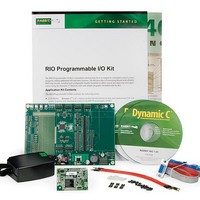101-1147 Rabbit Semiconductor, 101-1147 Datasheet - Page 4

101-1147
Manufacturer Part Number
101-1147
Description
KIT RIO PROGRAM I/O
Manufacturer
Rabbit Semiconductor
Series
Rabbit® RIO™r
Type
MPU Moduler
Datasheet
1.101-1147.pdf
(4 pages)
Specifications of 101-1147
Contents
RabbitCore Module, Dev. Board, AC Adapter, Cable and Dynamic C® CD-Rom
Processor To Be Evaluated
RCM4100
Data Bus Width
8 bit
Interface Type
SPI
Silicon Manufacturer
Rabbit
Silicon Family Name
Rabbitcore
Kit Contents
Board
Features
Multiple Communication Interfaces
Development Tool Type
Hardware / Software - Dev Kit (Dev Tool)
Rohs Compliant
Yes
For Use With/related Products
RCM4100
Lead Free Status / RoHS Status
Vendor undefined / Vendor undefined
Starting Dynamic C
Once the RCM4110 is connected as described in the preceding pages, start Dynamic C by double-clicking on
the Dynamic C icon on your desktop or in your Start menu. Dynamic C uses the serial port specified during
installation.
If you are using a USB port to connect your computer to the RCM4110, choose Options > Project
Options and check “Use USB to Serial Converter” in “Serial Options.” Click OK to save the settings.
Run a Sample Program
Use the File menu to open the sample program ROTATELED.C in the Dynamic C SAMPLES\RIO folder.
Press function key F9 to compile and run the program.The four LEDs on the Prototyping Board will flash on
and off in a rotating sequence, and the Dynamic C STDIO window will open on your PC to display the status
of the Rabbit RIO chip’s Channel 1.
This sample program uses Channel 1 with the Rabbit RIO chip operating in the SPI clocked serial communi-
cation mode. The Rabbit RIO Chip User's Manual describes the communication modes in more detail.
Where Do I Go From Here?
If the sample program ran fine, you are now ready to go on to other sample programs and to develop your
own applications. Application Note AN415, RIO Programmable I/O Kit, discusses how to use the Prototyp-
ing Board and explains the sample programs and Rabbit RIO function calls. The source code for the sample
programs is provided to allow you to modify them for your own use. The RCM4100 User's Manual on the
Dynamic C CD also provides complete hardware reference information and describes the software function
calls for the RCM4110 RabbitCore module, and the Rabbit RIO User's Manual provides complete reference
information for the Rabbit RIO chip.
Troubleshooting
If Dynamic C cannot find the target system (error message "No Rabbit Processor Detected."):
•
•
•
If there are no faults with the hardware, select a different COM port within Dynamic C. On your computer,
open Control Panel > System > Hardware > Device Manager > Ports and look at the list of available
COM ports. In Dynamic C, select Options > Project Options, then select one of the available COM ports
on the “Communications” tab, then click OK. Press <Ctrl-Y> to force Dynamic C to recompile the BIOS. If
Dynamic C still reports it is unable to locate the target system, repeat the above steps for another available
COM port. You should receive a Bios compiled successfully message once this step is com-
pleted successfully.
If a program compiles and loads, but then loses target communication before you can begin debugging, it is
possible that your PC cannot handle the default debugging baud rate. Try lowering the debugging baud rate.
•
If there are any other problems:
•
•
•
Check that the RCM4110 is powered correctly — the red power LED on the Prototyping Board should be
lit when the RCM4110 is mounted on the Prototyping Board and the AC adapter is plugged in.
Check both ends of the programming cable to ensure that they are firmly plugged into the PC and the
PROG connector, not the DIAG connector, is plugged in to the programming port on the RCM4110.
Ensure that the RCM4110 module is firmly and correctly installed in its socket on the Prototyping Board.
Locate the Serial Options dialog in the Dynamic C Options > Project Options > Communica-
tions menu. Choose a lower debug baud rate.
Use the Dynamic C Help menu to get further assistance with Dynamic C.
Check the Rabbit Semiconductor Technical Bulletin Board at www.rabbit.com/support/bb/.
Use the Technical Support e-mail form at www.rabbit.com/support/.
NOTE: If you purchased your RIO Programmable I/O Kit through a distributor or through a Rabbit
Semiconductor partner, contact the distributor or partner first for technical support.
020–0124 • 070715–C











